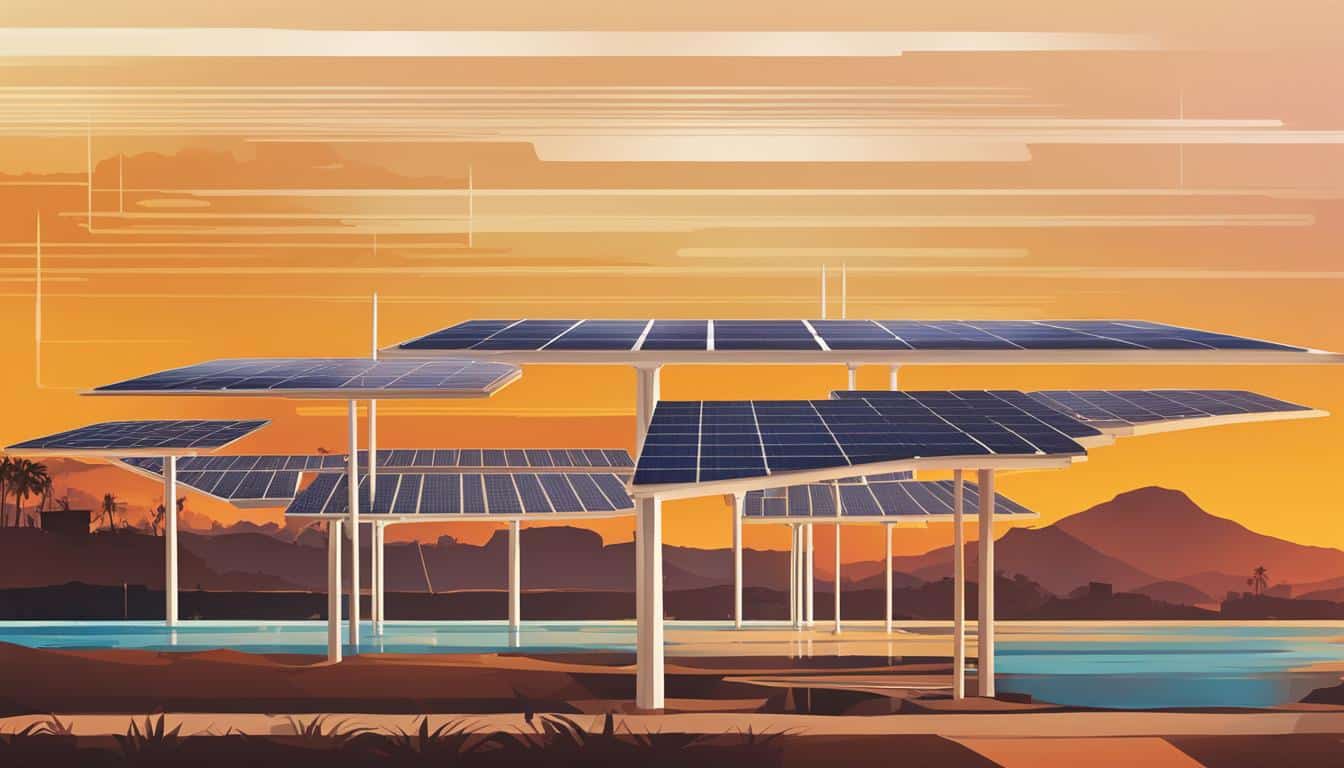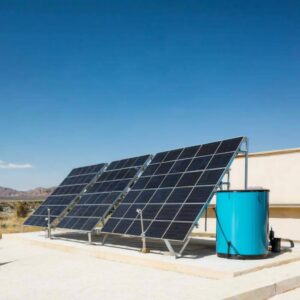
Solar energy has undergone a significant evolution throughout history, from its early uses in ancient civilizations to the modern advancements of today. Currently, there are over 37,000 MW of solar projects operating in the United States, with another 112,000 MW under development. The country has more than 2.9 million individual solar installations and a total solar capacity of 103 GW, enough to power 18.6 million homes. Solar energy has become a prominent and vital part of the renewable energy industry, and its growth is projected to continue in the future.
Key Takeaways:
- Solar energy has witnessed significant growth and development throughout history.
- The United States possesses a substantial solar infrastructure with millions of solar installations.
- Solar energy plays a crucial role in the renewable energy industry.
- The capacity of solar energy is enough to power millions of homes.
- Solar energy is expected to continue growing in the future.
What is Solar Energy?
Solar energy is a powerful and sustainable energy source that harnesses the sun’s rays to generate heat and electricity. It is a renewable energy technology that is helping to reduce our dependence on fossil fuels and mitigate the impacts of climate change.
There are several methods to collect and distribute solar energy, including:
- Photovoltaics: This is the most common way to harness solar energy. Photovoltaic cells, also known as solar cells, convert sunlight directly into electricity through an electronic process. These cells are typically made of silicon and are used to power small electronic devices, homes, and even large commercial establishments.
- Solar Heating and Cooling: This method uses the sun’s energy to heat water or air for residential and commercial use. Solar thermal collectors, such as solar water heaters and solar air conditioners, capture the sun’s heat and transfer it to the desired medium.
- Concentrating Solar Power: Concentrating solar power systems use mirrors or lenses to concentrate a large area of sunlight onto a small receiver, which then converts the sunlight into heat. This heat can be used to generate electricity through steam turbines or even for industrial processes.
Photovoltaics is the most widely adopted method of solar energy conversion due to its versatility and efficiency. It has revolutionized the way we generate electricity, making solar power accessible to individuals and businesses worldwide.
This image illustrates the transformation of solar energy into electricity through photovoltaic panels, showcasing the sustainable potential of solar power.
Innovations Driving the Future of Solar Energy
As solar energy continues to evolve, several groundbreaking innovations are poised to shape its future even further. These advancements not only enhance efficiency but also expand the applicability of solar technology in various sectors.
- Bifacial Solar Panels: One of the exciting developments in solar technology is the advent of bifacial solar panels, which can capture sunlight from both sides. By utilizing reflected sunlight from the ground, these panels can achieve higher energy output compared to traditional single-sided panels. This technology is particularly advantageous in snowy or sandy environments where reflected light is abundant.
- Floating Solar Farms: As land availability becomes a pressing issue, floating solar farms have emerged as a sustainable solution. These installations on bodies of water not only generate electricity but also help reduce evaporation and improve water quality. Floating solar farms maximize space while harnessing sunlight efficiently.
- Solar-Powered Smart Grids: The integration of solar energy with smart grid technology is another innovation enhancing the reliability and efficiency of solar power. Smart grids utilize advanced communication and monitoring technologies to manage electricity distribution more effectively, allowing for better integration of solar energy and improved energy efficiency in homes and businesses.
- Perovskite Solar Cells: Research into perovskite solar cells is paving the way for higher efficiency and lower production costs. These next-generation solar cells promise to outperform traditional silicon cells and can be manufactured using less energy-intensive processes. The potential for mass production of perovskite cells could revolutionize the solar market, making solar energy even more accessible.
The Early History of Solar Energy
Solar energy has been used by humans for centuries. As early as the 7th century B.C., people used magnifying glasses to concentrate sunlight and light fires. In the 3rd century B.C., the Greeks and Romans utilized burning mirrors to light torches for religious ceremonies. Thousands of years before the invention of solar panels, solar energy was harnessed for various purposes. In the late 1700s and 1800s, solar energy was used to power ovens for long voyages and even to operate solar-powered steamboats.

These early examples of using solar energy showcase the ingenuity of ancient civilizations. The development of magnifying glasses and burning mirrors allowed them to harness the power of the sun for practical purposes. From starting fires to lighting torches, solar energy played a significant role in their daily lives.
“Solar energy has a rich history that dates back thousands of years. It’s fascinating to see how ancient civilizations found innovative ways to utilize this renewable resource.” – Dr. Jane Thompson, Solar Energy Historian
One notable application of solar energy during this time was the use of solar-powered steamboats. These boats were equipped with solar panels that captured sunlight and converted it into energy, propelling the vessels forward. This early use of solar energy in transportation demonstrated its potential to provide clean and renewable power.
The Advantages of Ancient Solar Energy Utilization
- Absence of pollution: Solar energy, especially when utilized through magnifying glasses and burning mirrors, produced no harmful emissions or pollution, making it an environmentally friendly energy source.
- Sustainability: The sun’s energy is infinite, making solar power a sustainable solution for centuries to come.
- Renewability: Solar energy can be harnessed each day as the sun rises, making it a renewable source with no risk of depletion.
Despite the limitations of ancient solar energy technology, its usage paved the way for the development of modern solar panels and the widespread adoption of solar energy as a viable alternative to traditional fossil fuel-based power sources.
The Invention of Solar Panels
The invention of solar panels has been a pivotal milestone in the evolution of solar energy. It has paved the way for harnessing the power of the sun to generate electricity efficiently and sustainably. One of the key figures in this journey is Charles Fritts, who is credited with creating the first solar cell in the early 1880s.
Fritts’ groundbreaking innovation involved using selenium coated with a thin layer of gold to create a photoelectric device that could convert sunlight directly into electrical energy. While his early solar cell had limited efficiency, it laid the foundation for further advancements in the field.
However, as solar technology progressed, the use of silicon became the preferred material for solar panels. In 1954, at Bell Labs, Daryl Chapin, Calvin Fuller, and Gerald Pearson developed the silicon photovoltaic cell, marking a significant breakthrough in solar energy. This silicon solar cell achieved an efficiency of 4%, which at the time was a remarkable achievement.
The development of the silicon photovoltaic cell revolutionized the solar industry by providing a more practical and efficient method of harnessing solar energy. Silicon-based solar panels quickly gained popularity due to their higher efficiency, durability, and lower manufacturing costs compared to earlier designs.
Today, solar panel efficiency has come a long way. Modern solar panels can achieve conversion rates of 15-20%, making them highly efficient in converting sunlight into electricity. These advancements have made solar energy an increasingly viable and sustainable solution for meeting our growing energy needs.
The Growth of Solar Energy Today
Solar energy has experienced a remarkable surge in growth in recent years, establishing itself as a dominant force in the renewable energy sector. According to the Solar Energy Industries Association, the United States has witnessed an average annual growth rate of 50% in solar energy over the past decade. This exponential growth can be attributed to several key factors that have propelled the solar industry forward.
One of the critical factors driving the growth of solar energy is the Solar Investment Tax Credit (ITC). The ITC offers significant financial incentives to individuals and businesses that install solar panels, promoting widespread adoption of solar technology. Additionally, the decreasing costs of solar installations have made solar energy more accessible and affordable, further fueling its growth.
As an environmentally friendly and sustainable source of power, solar energy has also gained popularity due to the increased demand for clean energy solutions. In 2020 alone, more than 230,000 Americans worked in the solar industry, a clear indication of the extensive employment opportunities created by this booming sector. With over 10,000 companies dedicated to solar energy, including solar farms, the industry has become a significant contributor to job creation and economic growth.
The growth of solar energy has not only reshaped the energy landscape but also transformed the way we power our homes and businesses. The increasing affordability and the positive environmental impact of solar panels have led to a surge in residential installations and an impressive adoption rate of solar power across the country. As solar energy continues to expand, its role in shaping a sustainable and clean future for the United States becomes increasingly evident.
FAQ
What is solar energy?
Solar energy is the conversion of energy from the sun into heat and electrical energy. It can be collected and distributed through various methods, including photovoltaics, solar heating and cooling, and concentrating solar power.
How does photovoltaics work?
Photovoltaics is the most common way to harness solar energy. It directly converts sunlight into electricity through an electronic process. This technology can be used to power small electronic devices, homes, and large commercial establishments.
How has solar energy been used throughout history?
Solar energy has been used by humans for centuries. In ancient times, people used magnifying glasses to concentrate sunlight and light fires. The Greeks and Romans utilized burning mirrors to light torches for religious ceremonies. Solar energy was also harnessed to power ovens for long voyages and operate solar-powered steamboats in the late 1700s and 1800s.
Who invented solar panels?
Charles Fritts is credited with creating the first solar cell in the early 1880s using selenium coated with a thin layer of gold. However, modern solar panels are made with silicon. In 1954, Daryl Chapin, Calvin Fuller, and Gerald Pearson developed the silicon photovoltaic cell at Bell Labs, which marked a significant breakthrough in solar technology.
What is the efficiency of solar panels?
The first silicon solar cell achieved an efficiency of 4%. Since then, solar panel technology has improved, and current panels have conversion rates of 15-20%, making them more efficient in converting sunlight into electricity.
How has solar energy grown in recent years?
Solar energy has experienced rapid growth in recent years, with an average annual growth rate of 50% in the United States over the past decade. This growth can be attributed to factors such as the Solar Investment Tax Credit, decreasing costs of solar installations, and increased demand for clean energy. As of 2020, there are over 230,000 Americans working in the solar industry, and the popularity and affordability of solar energy have led to more residential installations and a greater adoption of solar power as a renewable energy source.






